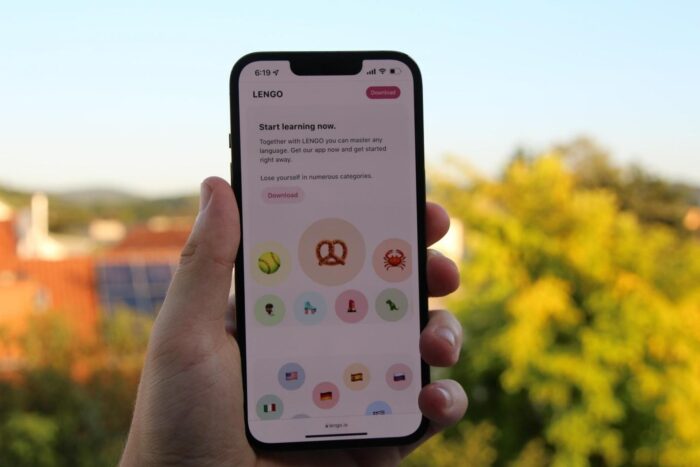9 Ways to Build More Fluency When Learning a Foreign Language
Read other articles:
Back to posts
Table of Contents
- 1 1. Plan a trip to engage with native speakers
- 2 2. Hook up with a language buddy
- 3 3. Book online language lessons with a tutor
- 4 4. Learn from YouTube tutors
- 5 5. Watch YouTube or Netflix videos
- 6 6. Use language learning apps
- 7 7. Practice listening
- 8 8. Learn from songs in the target language
- 9 9. Read more in the target language
- 10 Boost language learning for free
When learning a language, most people start by gathering the “building blocks” together: understanding the basic grammar rules, vocabulary, spelling, pronunciation and so on.
This helps you build a certain level of fluency and you can make great strides forward but it might not compel you to go much further after the initial inspiration starts to wear off. Many learners hit a “brick wall” at some point when they seem to be making no more progress. They reach a level where they struggle to improve their fluency.
How can you crack the code and lift yourself out of this language stasis?
Here are some great ways to build fluency and get back on track to learning the language to a high level of proficiency….
1. Plan a trip to engage with native speakers

This one’s the costliest option and may not be practical but let’s start with big dreams.
Learning from native speakers is essential for effective and efficient foreign language learning. So, how about planning a trip to a place that speaks the language you’re learning?
That’s easier if you’re from the UK and learning French than if you’re a Canadian learning Portuguese. But, by visiting a land where the target language is spoken natively, you can fully immerse yourself in the language. Some learners might find this intimidating but there’s a lot to be said for being thrown in at the deep end when you’re learning to swim.
You can start by learning the language for some of the travel situations you’ll find yourself in. For more advanced learners who have hit the “brick wall”, a trip should give you new impetus and inspiration to pick up your language learning again.
2. Hook up with a language buddy

If your first language is English and you’re learning Portuguese, try to find a language buddy from Portugal, Brazil, Mozambique, Angola or another Portuguese-speaking country who wants to learn English.
This is relatively simple in the age of social media. With search filters, friend requests, online chat and video, you can find digital language buddies to practice within a matter of minutes. Facebook, Instagram, WhatsApp, Zoom…you have all you need on your phone or laptop for regular communication with native speakers.
Because you’re both native speakers of each other’s target language, you’ll each have a personal language “monitor” or tutor. This is a great help for correcting mistakes, teaching new phrases and idioms and adding color to the language. Learning becomes more memorable and you can both gain confidence in using the target language from the experience.
Consider this option a “dry run” before you book a trip to a target language destination and you naturally start to immerse yourself in the language with native speakers.
And why stop at one language buddy? Get several for a variety of interactions – even better for improving language fluency and confidence!
3. Book online language lessons with a tutor

Online language lessons can give you new impetus to learn in your own time, at your chosen speed and about the topics that interest you — with professional guidance.
Even before COVID, many language tutors had moved online and were offering lessons or entire courses to take from home. Ideally, your tutor will engage with you only in the target language — so that you become familiar with practicing with a native speaker and you can build confidence that way.
Demotivated students who have hit a brick wall can gain new impetus from at least a few paid lessons. Your tutor can correct mistakes, introduce new concepts and vocabulary and point you in the right direction — all important parts of the learning process that can rekindle interest and motivation.
4. Learn from YouTube tutors

Native-speaking YouTube language tutors are available in almost any language you’d care to mention.
YouTube is a great place to start but be sure to delve deep into the content lists as some of the highest-ranking videos appear to be little more than vocabulary lists and use a basic grammar-translation method for teaching languages.
The best YouTube tutors make videos in the target language, include subtitles and help you understand cultural context by covering a variety of situations and experiences and highlighting the learning points from them.
5. Watch YouTube or Netflix videos

Movies, documentaries, TV shows… video platforms are like online language labs for language learners. You get to learn from native speakers, within a cultural context, at your own pace and in a relaxed environment.
With a ton of engaging video content out there and available for free in many cases, it’s surprising that all learners of second languages aren’t using movies and TV shows constantly for exposure to the target language.
And now, as AI and machine learning develop at pace alongside this great content, new apps are springing up to aid the process of learning from YouTube and Netflix in a video environment.
This one is a free Chrome Extension that is specially designed for building language fluency from subtitled videos. Using this free app, there’s no need to write down the new phrases you learn — you can save them directly from the YouTube video into the app and build your own library.
6. Use language learning apps

An entire ecosystem of language-learning apps has sprung up in recent years as the commercial opportunities of language-learning software have prompted many to do what Rosetta Stone started in the 1990s.
These apps, such as Duolingo, Babbel, Busuu, Memrise, Mondly, and so on, are downloaded millions of times on smartphones around the world. Many just sit there unused but some learners love having a “pocket language tutor” who follows them around.
Most of the apps aim for an engaging learning experience with games, quizzes, rewards, stickers and more. This may or may not work for you. If nothing more, they can act as pocket dictionaries for help with learning vocabulary.
7. Practice listening

Most of the emphasis in language courses tends to be on speaking and writing, i.e., output from the learner. That might be because it’s measurable.
However, as Stephen Krashen points out, comprehensible input is one of the keys to efficient language learning. This means that listening and reading skills are essential if you want to master a language.
The problem is that few people are taught how to listen. And, in this age of distraction and low attention spans, it’s even more important to understand the value of the listening process and how it aids learning.
The solution? Find topics of interest that engage you and you’ll become a better listener. With all the wonderful content available on video and podcast platforms, it should be simple to find topics of interest at the level you require in the target language.
Whether it’s cartoons or cookery, football or fossil collecting, being interested or emotionally “invested” in a topic aids the learning process and makes it more likely that you’ll delve deeper into the language.
8. Learn from songs in the target language

Another great example of “emotional investment” boosting learning is when using native songs to learn a language. The music makes the lyrics memorable.
In the context of language learning, music combines entertainment and education. These often go very well together and the word edutainment has even entered the dictionary.
If you enjoy songs in the native language and want to know their meaning, you’ll be compelled to translate them and, in doing so, you’ll naturally learn new phrases and pronunciations.
You need to be careful with context when learning from songs as the phraseology and vocab used in music are often emotional and very specific to certain situations — love, loss and grief are good examples. Most people want to avoid sounding “silly” and don’t generally go around talking in song lyrics unless they’re making a joke!
9. Read more in the target language
Another essential aspect of Krashen’s comprehensible input hypothesis is reading in the target language.
Like with listening, the level of the content needs to be pitched just above what learners are comfortable with so that they can understand the topic but it challenges their knowledge of the language, compelling them to learn new phrases, vocab or sentence structure, for instance.
This can help learners improve foreign language fluency because it not only expands the vocabulary but builds confidence in using new words and phrases correctly in context.
With so much online content to choose from, it should be relatively simple to find topics of interest in blog posts and articles pitched at the right level to challenge you and inspire learning.
Boost language learning for free
Learning by imitation and immersion is largely how children learn — and they’re usually very good at it.
The above methods focus on learning through interaction with native speakers — where you learn mainly by imitating them.
Whether that’s through in-person interactions, virtual meetings, online video, movies, TV programs, books, websites or other means, there’s no substitute for these native-speaker interactions if you want to ramp up your fluency in a foreign language.
Immerse yourself in your target language from the comfort and relaxation of your home with our free Chrome extension for YouTube videos.
Read other articles:
Back to posts
